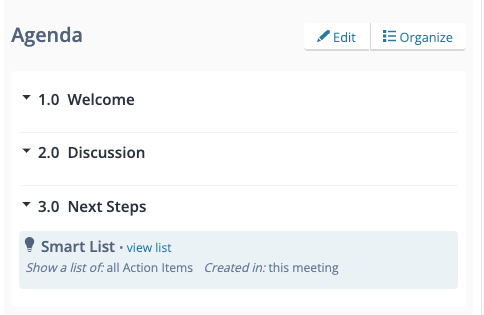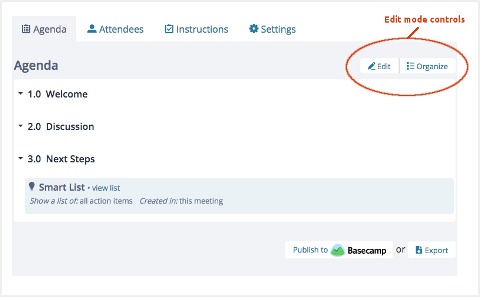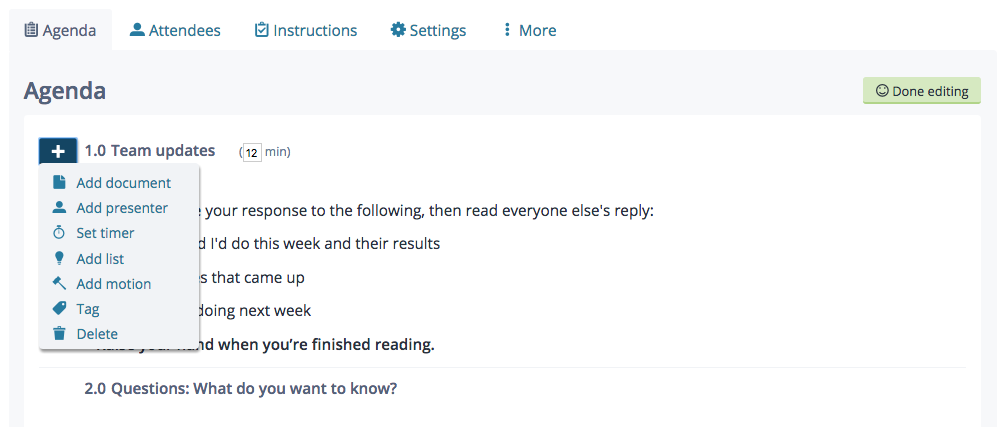Every Lucid Meeting has an agenda. An agenda can be as simple as a single item, or it can provide detailed structure to your meeting.
A well-structured agenda provides an organized view of the meeting topics and helps all participants arrive prepared for the discussion.
 A simple agenda
A simple agenda
A meeting agenda is composed of one or more agenda items. Each agenda item is composed of these elements:
Agenda Item Number: The agenda item number is assigned automatically when you add or re-arrange agenda items. During the meeting, the meeting facilitator clicks the agenda number shown at the top of the screen to advance the meeting forward.
Sub-Topics: Any agenda item can have sub-topics to dive into a topic further. Ex: 2.1, 2.2, 2.3. Sub-topics allow a facilitator to present multiple items that relate to the main topic and keep everyone focused on the same agenda item at the same time.
Title: The agenda item title is the only required field for an agenda item, and should summarize the main subject of the agenda item. When the agenda is collapsed, the agenda item number and title are visible while all other details are hidden.
Presented by: The presenter will lead the discussion on this topic during the meeting. Presenters can update and present their assigned agenda items.Estimated durationHow many minutes do you plan to spend on this topic? The in-meeting timer will show the estimated duration and elapsed time for each agenda item and the meeting as a whole, helping you keep on schedule.
Description: The agenda item description can be as long as needed and will be included in the post-meeting record.
Smart List: Smart Lists dynamically present notes and/or action items for review during your meeting, such as open action items from previous meetings or meeting notes tagged as decisions.
Documents: Add reference documents and presentations. You can add any kind of document. To interactively present a document during the meeting, upload a document in PDF, MS Office (Word, PowerPoint, Excel), or image format.
URL/Link Presentation: You can add a URL to an agenda item, and it will be available to present during the meeting. By default, URLs will "presented" by opening a new window in each user's browser. An embedded display is available for links that can be embedded (many sites don't allow this).
Add a Smartsheet: Smartsheet makes it easy to share your work with other team members, or simply collaborate on a specific task. You can easily add a Smartsheet to an agenda then share and display them during meetings.
Add a Stormz Workshop: Easily add Stormz workshops to your Lucid agendas, launch and facilitate Stormz workshops during meetings, and retrieve the report for a Stormz workshop then attach it to your Lucid meeting record.
Proposed Motions: Some meetings are for making decisions. When you know ahead of time that a motion will be brought up for discussion and vote, you can add it to the agenda to help everyone get prepared to vote.
Whenever a meeting is created, an agenda is automatically added to it. Meeting facilitators can update any part of the agenda. Agenda item presenters and attendees in meetings where "everyone can present" can update any existing agenda item, but cannot add new items.
To edit an agenda item:
You can edit agenda items before, during, and after a meeting.
- Click the Edit button in the upper right corner of the agenda.

- Click any text in the agenda to edit it.
- For more options, click the plus sign (+) and make a selection from the drop-down menu.
- To save, click Done editing.

Editing the agenda
During a meeting, select the Agenda widget at the bottom of the meeting display to bring up the agenda. Edit as needed, using the steps above.
To re-order the agenda:
- Click the Organize button in the upper right corner of the agenda. (If you've been editing, click Done editing first.)
- Click the arrow buttons next to each item to move agenda items. Use the right arrow to create a sub-topic.
- Alternatively, you can drag and drop agenda items to either re-order them or create sub-topics in this view.
- To save, click Done editing.

Re-ordering the agenda
Once the agenda is complete you have the option to export (download) it in Word, PDF, HTML, Text, or Markdown format. You may have additional options depending on what integrations you have enabled for your organization.
Email invitations include the top-level agenda items, invited attendees, and the full agenda with descriptions and durations. Sending the invitation out ahead of time allows attendees to review that agenda and prepare in advance. You may also choose to attach a full HTML agenda to the meeting invitation.
